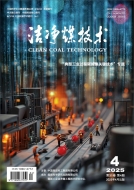Biomass, as a renewable energy source, has the advantages of abundant content, easy ignition and low pollutant emission, but has the disadvantages of low energy density and high moisture. Coal powder has the advantages of high energy density and disadvantages of difficult ignition and high pollutant emission. Combining firing carbon neutral energy biomass to pulverized coal at a high blending ratio (the mass ratio of biomass to coal is greater than 5∶5) can effectively solve the problems of the low utilization rate and low energy density of biomass, and the difficult ignition and high pollutant emissions of coal, improve energy utilization rate, achieve the goal of energy conservation and emission reduction, which has become a new energy utilization technology. At present, scholars merely investigate the co-combustion characteristics at low blending ratio (less than 5∶5), deeper insight into the co-combustion characteristics of biomass and coal at high blending ratio is required. The combustion characteristics and kinetic characteristics of coal powder and different biomasses (corn stalk, rice stalk, corn cob, cotton and poplar sawdust) at distinct blending ratios (0∶10, 5∶5, 6∶4, 7∶3, 8∶2 and 10∶0) were studied by thermogravimetric analysis. The effects of biomass species and blending ratio on fuel heat loss characteristics, characteristic temperature, reaction kinetics, burnout characteristics and combustion characteristic index of mixed samples were analyzed, and the optimal blending ratio of different biomass was determined. The results show that the weight loss curve of the mixing samples show three stages: water-loss stage, volatile-combustion stage and fixed carbon-combustion stage. The maximum weight-loss rate decreases in the first stage and increases in the second stage, and the combustion process advances. The ignition temperature and burnout temperature decrease by about 100 ℃ and 40 ℃, respectively, compared with that of pulverized coal. Under the synergistic effect of promotion and inhibition, the ignition temperature of poplar sawdust increases gradually with the increase of mixing proportion. Corn straw, rice stalk and cotton decrease firstly and then increase, and the minimum is at 7∶3,while corn cob gradually decreases. And the burnout temperature of all species decreases. The activation energy of single biomass is lower than that of pulverized coal. In the first stage, the rankingis rice stalk, poplar sawdust, corn stalk, cotton and corn cob from the largest to the smallest, while in the second stage, the ranking is poplar sawdust, cotton, corn cob, rice stalk and corn stalk. With the increase of blending ratio, cotton and poplar sawdust increases first and then decreasesin the first stage, while corn cob and rice stalk decrease gradually, and both of them are minimum at 8∶2. Corn stalk decreases first and then increases after blending, and the minimum is at 6∶4. In the second stage, corn cob, poplar sawdust and cotton gradually decrease, and the minimum at is 8∶2. Corn straw and rice stalk decrease first and then increase, and the minimum value is at 6∶4 and 7∶3, respectively. The changes of burnout characteristic index are different. Cotton has the strongest inhibition effect at 7∶3, while corn straw, rice stalk, corn cob and poplar sawdust have the strongest promotion effect at 8∶2, 6∶4, 6∶4 and 8∶2, respectively. The comprehensive combustion characteristic indexes of single biomass from the largest to the smallest are corn cob, cotton, corn stalk, rice stalk and poplar sawdust, which are about 10.0 times, 7.7 times, 7.0 times, 6.5 times and 6.2 times of coal powder. Corn cob and cotton reach the maximum value at 8∶2, and rice stalk and corn straw reach the maximum value at 7∶3. The combustion characteristic index has almost no change when the mixing proportion is changed in a small scope.
Experiment of co-combustion characteristics of different biomass andpulverized coal at high blending ratio
 2023 No. 05
2023 No. 05
 539
539 365
365

Authors:
- LI Meijun

Unit:
- Beijing Tiandi Rongchuang Technology Co.

Abstract:

Keywords:
- pulverized coal
- biomass
- highblending ratios
- thermogravimetric analysis
- co-combustion characteristics
- combustion characteristic index

Citation format:
李美军(1988— ),女,河北沧州人,助理研究员,博士。E-mail:limeijunFiona@163.com

Chart:

Articles:
--

Citation format:
LI Meijun.Experiment of co-combustion characteristics of different biomass and pulverized coal at high blending ratio[J].Clean Coal Technology,2023,29(5):80-88.

-
Executive director
China Coal Science and Industry Group Co., Ltd
-
Sponsored by
Coal Science Research Institute Co., Ltd
Coal Industry Clean Coal Engineering
Technology Research Center -
Editor in Chief
XIE Qiang
-
Vice Editor-in-Chief
YU Chang
SHI Yixiang
ZHAO Yongchun
DUAN Linbo
CAO Jingpei
ZENG Jie -
Publication Frequencies
Monthly
-
ISSN
1006-6772
-
CN
11-3676/TD
Covered by
- CSTPCD
- RCCSE(A+)
- AJ
- EBSCO host
- Ulrichsweb
- JST
- Scopus
Contact us
New Media
-
 Meichuanmei
Meichuanmei -
 Clean Coal Technology
Clean Coal Technology -
 Online Journals
Online Journals







 Submission system
Submission system Copyright agreement
Copyright agreement Instructions for authors
Instructions for authors